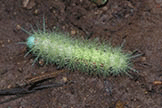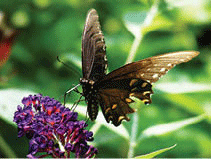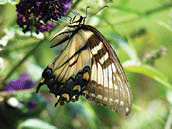

 One of the more beautiful things in all of the creation is the butterfly. In recent years commercial tourist areas have found that there is an attraction called a “butterfly house” which is very popular with older tourists. I can remember when my wife Phyllis was near her death that we went into one of those butterfly houses where I got involved in a discussion with one of the curators of the facility and he took me to “the ugly house” where the caterpillars were being fed and starting their cocoons. When I got back I found Phyllis sitting on a large rock literally covered with beautiful butterflies. She smiled at me and said “I have finally found a blessing in being diabetic.” Apparently the insects could detect her higher than normal blood sugar, and when she sat still they were attracted to her. She was covered with beautiful butterflies with all kinds of colors and textures. Those colors are actually not pigments, but a special way in which light can be bent and manipulated to give brilliant colors without chemical pigments. Not only are there physics lessons we can learn from butterflies, but there are some messages about our struggles in life that can be learned from butterflies as well.
One of the more beautiful things in all of the creation is the butterfly. In recent years commercial tourist areas have found that there is an attraction called a “butterfly house” which is very popular with older tourists. I can remember when my wife Phyllis was near her death that we went into one of those butterfly houses where I got involved in a discussion with one of the curators of the facility and he took me to “the ugly house” where the caterpillars were being fed and starting their cocoons. When I got back I found Phyllis sitting on a large rock literally covered with beautiful butterflies. She smiled at me and said “I have finally found a blessing in being diabetic.” Apparently the insects could detect her higher than normal blood sugar, and when she sat still they were attracted to her. She was covered with beautiful butterflies with all kinds of colors and textures. Those colors are actually not pigments, but a special way in which light can be bent and manipulated to give brilliant colors without chemical pigments. Not only are there physics lessons we can learn from butterflies, but there are some messages about our struggles in life that can be learned from butterflies as well.
LESSON 1 — WE NEED TO PUT THE PAST BEHIND US AND LOOK TO THE FUTURE. Webster defines a caterpillar as “the worm-like, often hairy larva of the lepidopterous insect.” Caterpillars and cocoons are usually pretty ugly. I mentioned that the curator took me to their “ugly house.” This was a very warm room full of milkweed and other plants that the caterpillars of various butterflies eat. Each plant was covered with a multitude of caterpillars that were munching on the leaves. Webster’s definition is pretty accurate. The caterpillars came in a variety of colors and patterns, mostly for camouflage purposes, but they were covered with hairs and spikes, and their worm-like bodies were tipped with very nasty looking heads. I am told that in horror movies, caterpillar enlargements are used because they are more vicious looking than any fictitious animal.
 When the caterpillar starts to build its cocoon, it leaves all of its past behind. No longer will it eat plants, which was its main activity as a caterpillar. It will lose its entire body and all of its hairs and legs. The transformation is complete and everything that was a part of its previous existence is left behind.
When the caterpillar starts to build its cocoon, it leaves all of its past behind. No longer will it eat plants, which was its main activity as a caterpillar. It will lose its entire body and all of its hairs and legs. The transformation is complete and everything that was a part of its previous existence is left behind.
In the same way, when a person becomes a Christian he has to leave everything that has been a part of his past existence behind. Paul said in Philippians 3:12 –14 (NIV 1984), “Not that I have already obtained all this, or have already been made perfect, but I press on to take hold of that for which Christ Jesus took hold of me. … I do not consider myself yet to have taken hold of it. But one thing I do: Forgetting what is behind and straining toward what is ahead, I press on toward the goal to win the prize for which God has called me … .” In 1 Timothy 1:15 (NIV) Paul talks about his past saying, “Christ Jesus came into the world to save sinners — of whom I am the worst.” Many of us, including your writer, have a past that they are ashamed of. All of us have a past, and our mistakes in the past can paralyze us if we will let them.
Like the caterpillar we have to leave all of that behind. The beauty of baptism is that it allows us to bury the past. Romans 6:3 –11 beautifully portrays becoming a Christian through baptism as an act of dying to sin — the same kind of metamorphosis that the caterpillar goes through. You can destroy yourself and everyone you love by continuing to allow the past to torment you. In 2 Corinthians 5:17 (NIV) it is stated beautifully, “Therefore, if anyone is in Christ, the new creation has come. The old has gone, the new is here!” No one looking at a beautiful butterfly would imagine that it was once an ugly caterpillar. By leaving the past behind and starting new, we can have just as radical a transformation.
 LESSON 2 — WE HAVE TO USE WHAT GOD HAS ALREADY GIVEN US. Suppose that for some reason a caterpillar decides it does not want to be a butterfly so it starts digging its way out of the cocoon. What would be the result? Have you ever tried to cut open a cocoon? Let me tell you what happens if you do that. You get a mess. You will not see anything you recognize. The caterpillar has dissolved and the makings of a butterfly are not recognizable. You have a gooey mess that is completely dysfunctional.
LESSON 2 — WE HAVE TO USE WHAT GOD HAS ALREADY GIVEN US. Suppose that for some reason a caterpillar decides it does not want to be a butterfly so it starts digging its way out of the cocoon. What would be the result? Have you ever tried to cut open a cocoon? Let me tell you what happens if you do that. You get a mess. You will not see anything you recognize. The caterpillar has dissolved and the makings of a butterfly are not recognizable. You have a gooey mess that is completely dysfunctional.
In the same way, each of us has a purpose for which God created us. Ephesians 4:7 tells us that Christ “apportioned” grace to each of us. First Corinthians 12:4 – 7 (NIV 1984) points out that “there are different kinds of gifts, but the same Spirit. There are different kinds of service, but the same Lord. There are different kinds of working, but the same God works all of them in all men. Now to each one the manifestation of the Spirit is given for the common good.” Verse 11 tells us that all of these abilities are the work of God. God takes us where we are and with whatever tools we have in us and uses them in wonderful and incredible ways. Trying to be something you are not and failing to use your talents is a mistake.
LESSON 3 — DO NOT BE AFRAID TO TRUST GOD. The caterpillar has a rough life. It gets eaten by birds; it is incredibly slow so any journey to another food source is an ordeal; it is constantly bombarded by chemicals both from the plants it is eating and by external sources. In spite of all that, if it survives it will become whatever God intended it to be. Romans 8:28 (NIV 1984) tells us, “And we know that in all things God works for the good of those who love him, who have been called according to his purpose.” That does not mean that God causes the problems, or that the problems will not be severe. It just says that if we will not cave in to the problems, God will make good things come from our bad experiences.
I can personally testify as to how this happens. In May 2008 my wife of 49 years died. It was a terrible experience, but I have seen God bring incredible blessings and even joy into my life since my wife’s death. I trusted God would do this because he says he will, but it has happened in ways that I did not dream were possible. In 1962 our first baby was born with cerebral palsy, blindness, muscular dystrophy, schizophrenia, and mental retardation. The pain and the frustration with that combination of afflictions have been huge, but I know that whatever good there is in my character today has come at least in part from that experience. First Corinthians 10:13 tells us that there are common experiences that we will have in life which will tempt us, but goes on to make the promise that God will always be there and that he will also provide a way out of the temptation we face.
 Our analogy with the caterpillar fails in this lesson because caterpillars are not created in the image of God and since they are not sentient beings they cannot choose to t rust or distrust God. In a sense, all living things trust God because their instincts are programmed to an end that has been incredibly successful in the history of this planet. In our case, we are not instinctively driven and can choose not to trust God but to try to do things our way. Many people told us to dispose of our son Tim as an unfit burden that would destroy our lives. There is no question that his problems changed our lives, but that change has enriched us and provided us with a way to grow in our love and trust of God. Trust God to work things out for you. Whatever the problem is, he will find answers for you. It is not always easy, but it always turns out to be good as Romans 8:28 says.
Our analogy with the caterpillar fails in this lesson because caterpillars are not created in the image of God and since they are not sentient beings they cannot choose to t rust or distrust God. In a sense, all living things trust God because their instincts are programmed to an end that has been incredibly successful in the history of this planet. In our case, we are not instinctively driven and can choose not to trust God but to try to do things our way. Many people told us to dispose of our son Tim as an unfit burden that would destroy our lives. There is no question that his problems changed our lives, but that change has enriched us and provided us with a way to grow in our love and trust of God. Trust God to work things out for you. Whatever the problem is, he will find answers for you. It is not always easy, but it always turns out to be good as Romans 8:28 says.
There is no way to get to be a butterfly other than the one that involves being a caterpillar and building a cocoon. There is no other way to live eternally than to become a Christian and to live as God has called us to live. Ultimately the butterfly is free of the things that afflicted it as a caterpillar. It can now fly and move freely at great speeds. The butterfly is a thing of beauty, and a wonder to behold. In the same way becoming a Christian can be done only by God’s method, and ultimately the same freedom and beauty will be ours.
Picture credits:
Cover: Roland Earnst
en.wikipedia.org/wiki/File: Monarch_In_May.jpg
en.wikipedia.org/wiki/File:Hairy_caterpillar_(Costa_Rica).jpg
Roland Earnst
Roland Earnst
